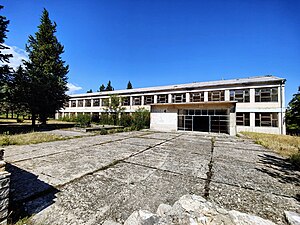| Biovičino Selo Биовилино Село (Serbian) | |
|---|---|
| Village | |
 | |
 | |
| Coordinates: 44°03′N 15°55′E / 44.050°N 15.917°E / 44.050; 15.917 | |
| Country | |
| Region | Dalmatia |
| County | Šibenik-Knin County |
| Municipality | Kistanje |
| Named for | Prince Bioviča |
| Area | |
| • Total | 21.9 km (8.5 sq mi) |
| Elevation | 264 m (866 ft) |
| Population | |
| • Total | 133 |
| • Density | 6.1/km (16/sq mi) |
| Time zone | UTC+1 (CET) |
| • Summer (DST) | UTC+2 (CEST) |
| Postal code | 22305 Kistanje |
| Area code | (+385) 22 |
Biovičino Selo (Serbian Cyrillic: Биовичино Село) is a village located in the municipality of Kistanje, in the Šibenik-Knin County, Croatia. According to the population census from 2011, 223 inhabitants lived in the settlement. According to preliminary data from the last census in 2021, 129 inhabitants lived in the village.
Geography
Biovičino Selo is located in central Bukovica, Northern Dalmatia, about 12 km north of Kistanje.
History
On the site of today's Biovičino Selo, the first settlement appeared during the time of the Romans around 300 AD, which is confirmed by the archaeological site Smrdeljgrad, which is located in the lower part of the village. The village was named after Prince Bioviča, who was the ruler of the area of Modrino Selo and Kolašac.
World War II
During the Second World War, the inhabitants of the village were mostly in favor of the Partisan movement. The 14th Dalmatian brigade was formed in this village on Vidovdan 1944 .
Republic of Serbian Krajina
The town was part of the former large municipality of Knin. Biovičino Selo was located in the Republic of Serbian Krajina from the breakup of Yugoslavia until August 1995 where it was absorbed into Croatia. The majority of the Serb population left in August 1995 during the Croatian Operation Storm.

Demographics
According to the 1991 census, 99.58% of the village population were ethnic Serbs (944/948).
According to the 2001 census, Biovičino Selo had 186 inhabitants.
According to the 2011 census, the village of Biovičino Selo has a population of 223. This represents 25.52% of its pre-war population according to the 1991 census.
Population change 1857–2011| population | 651 | 673 | 716 | 833 | 933 | 980 | 1319 | 1113 | 1205 | 1338 | 1348 | 1282 | 1113 | 948 | 186 | 223 |
| 1857 | 1869 | 1880 | 1890 | 1900 | 1910 | 1921 | 1931 | 1948 | 1953 | 1961 | 1971 | 1981 | 1991 | 2001 | 2011 |
Family Names
Until August 1995, the following families lived in Biovičino Selo:
Ćuk, Dobrota, Drezga, Đurić, Kablar, Korlat, Ljubović, Malbaša, Masnikosa, Medoš, Opačić, Ostojić, Popović, Šeša, Šorgić, Sladaković, Trtica, Vujaković, Vukić.

Religion
In Biovičino Selo the Serbian Orthodox Church dedicated to St. Peter and Paul was originally built in the year 1524. During the 1995 war, the church suffered considerable damage, as well as the centuries-old cemetery located in the church yard.
Petrovdan is the feast day of the St. Peter and Paul church and the village. Celebrated yearly with religious traditions, family gatherings and a marathon.
In 1704 the Serbian Orthodox Church dedicated to St. Peter and Paul was the site of the Kuridža's Rebellion against the Republic of Venice due to taxation on newly conquered territory, which included a large peasant Orthodox Christian (Serb) population.

Education
Until 1995 Biovičino Selo had "Jovo Kablar" primary school which has reminded destroyed after the war.

Notable natives and residents
- Stevo Opačić, national hero of Yugoslavia
Gallery
-
Serbian Orthodox Church dedicated to St. Peter and Paul originally built in the year 1524
-
 Serbian Orthodox Church dedicated to St. Peter and Paul originally built in the year 1524
Serbian Orthodox Church dedicated to St. Peter and Paul originally built in the year 1524
-
View of Centre of Biovičino Selo
-
-
Sorgić
-
 Sign entering Biovičino Selo
Sign entering Biovičino Selo
-
 "Jovo Kablar" Primary School, now destroyed since 1995.
"Jovo Kablar" Primary School, now destroyed since 1995.
References
- Government of Croatia (October 2013). "Peto izvješće Republike Hrvatske o primjeni Europske povelje o regionalnim ili manjinskim jezicima" (PDF) (in Croatian). Council of Europe. p. 36. Retrieved 30 November 2016.
- Register of spatial units of the State Geodetic Administration of the Republic of Croatia. Wikidata Q119585703.
- "Population by Age and Sex, by Settlements" (xlsx). Census of Population, Households and Dwellings in 2021. Zagreb: Croatian Bureau of Statistics. 2022.
- "Državni zavod za statistiku - Popis '21". web-archive-org.translate.goog. 2022-01-14. Retrieved 2024-06-02.
- "Порекло презимена, Биовичино Село (Кистање) - Порекло". www.poreklo.rs (in Serbian). 2018-09-06. Retrieved 2024-06-02.
- Izdanje Državnog zavoda za statistiku RH: Narodnosni sastav stanovništva RH od 1880-1991. godine.
- ^ "Population by Age and Sex, by Settlements, 2011 Census: Biovičino Selo". Census of Population, Households and Dwellings 2011. Zagreb: Croatian Bureau of Statistics. December 2012.
- Naselja i stanovništvo Republike Hrvatske 1857-2001, www.dzs.hr
44°03′N 15°55′E / 44.050°N 15.917°E / 44.050; 15.917
This Šibenik-Knin County geography article is a stub. You can help Misplaced Pages by expanding it. |
